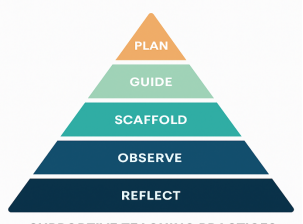This article explores the integration of Project-Based Learning (PBL) and Inquiry-Based Learning (IBL) within the framework of an extracurricular English language program for secondary school students titled “Enjoy English: Discover, Explore, Create.” The program, designed for Grades 5 to 9, aligns with Kazakhstan’s national education standards and international frameworks such as CEFR and PISA. The study outlines the structure and components of the program, highlights the use of active learning methods (e.g., digital storytelling, debates, research projects), and presents data on student progress in language competence, research literacy, and public speaking. Challenges in implementation are also discussed, along with practical recommendations for educators. The article concludes by emphasizing the value of extracurricular programs in enhancing learner motivation, autonomy, and 21st-century skills.
Keywords: project-based learning, inquiry-based learning, extracurricular education, English language club, active learning, research skills, student motivation, functional literacy, CEFR, secondary school
Introduction
In the modern educational landscape, English language learning extends beyond the boundaries of the traditional classroom. As students are expected to become not only proficient users of English but also critical thinkers and independent learners, extracurricular programs have gained increasing importance. These programs offer flexible environments that support personalized, inquiry-driven, and project-based learning experiences. Among the most promising approaches in this context are Project-Based Learning (PBL) and Inquiry-Based Learning (IBL), which emphasize learner autonomy, collaboration, and real-world application of language skills.
This article explores the integration of PBL and IBL within an authorial extracurricular English language program for students in Grades 5–9 titled “Enjoy English: Discover, Explore, Create.” Developed in alignment with Kazakhstan’s State Educational Standards and the CEFR, the program aims to develop learners’ communicative and research competencies through meaningful, student-centered tasks. The purpose of this paper is to present the theoretical underpinnings of these approaches, illustrate their implementation across different grade levels, and highlight their impact on learners’ motivation, functional literacy, and intercultural awareness.
Theoretical Background
Project-Based Learning (PBL) and Inquiry-Based Learning (IBL) are student-centered instructional approaches that align with the demands of 21st-century education. PBL engages learners in exploring real-world problems through long-term, collaborative projects, while IBL focuses on developing learners’ curiosity by encouraging them to ask questions, gather and analyze information, and draw conclusions based on evidence.
Both approaches have been widely recognized for their effectiveness in promoting learner autonomy, creativity, and higher-order thinking skills. According to Thomas (2000), PBL encourages deep content learning, critical thinking, and student engagement. Similarly, Bell (2010) highlights that IBL fosters independent exploration and supports a more personalized learning experience. When integrated into English language education, these methods not only develop language proficiency but also enhance students’ communication, collaboration, and research skills.
In Kazakhstan, modern educational reforms emphasize the integration of functional literacy, digital skills, and communicative competence. The extracurricular program “Enjoy English: Discover, Explore, Create” responds to these priorities by embedding PBL and IBL into its structure. The program builds learners' competencies through progressive, spiraling activities that develop from Grade 5 to Grade 9, providing meaningful opportunities for students to use English as a tool for exploration and self-expression.
Program Design and Implementation
The extracurricular program “Enjoy English: Discover, Explore, Create” is structured around three core components: Enjoy Grammar (language systems), Enjoy Projects (research and PBL/IBL tasks), and Enjoy Culture (intercultural and creative extracurricular activities). These elements are delivered through a spiral curriculum that ensures consistent development of language, research, and cultural competencies from Grades 5 to 9.
Table 1
Structure of the Program by Component (per academic year)
|
Grade |
Enjoy Grammar |
Enjoy Projects |
Enjoy Culture |
|
5 |
Basic structures |
Animal facts, hobbies, cultural traditions |
Storytelling, role plays, festivals |
|
6 |
Past & Perfect tenses |
Healthy lifestyle, famous people |
Legends, cultural exchange, reading circles |
|
7 |
Conditionals, passive |
Technology use, travel, environment |
Virtual tours, media projects, debates |
|
8 |
Advanced grammar |
Global citizenship, mental health |
TED-talks, podcasts, digital storytelling |
|
9 |
Complex structures |
Leadership, innovations, SDGs |
Youth forums, essay competitions, conferences |
The delivery of the program is grounded in active and participatory methodologies. Learners engage in:
— Collaborative projects and inquiry-based investigations
— Real-world communication tasks such as interviews, debates, surveys
— Digital content creation: blogs, podcasts, videos, infographics
— Public presentations: TED-style talks, exhibitions, role-plays
This design ensures that students not only practice English but also build research, media, and communication skills in engaging, learner-led formats.
Active Learning Methods
To ensure high student engagement and meaningful skill development, the extracurricular program employs a wide variety of active learning methods. These strategies not only support English language acquisition but also foster critical thinking, collaboration, creativity, and digital literacy.
Table 2
Key Active Learning Strategies Used in the Program
|
Method |
Description |
Example from the Program |
Skills Developed |
|
Project-Based Learning |
Long-term collaborative tasks solving real-life problems |
«My Dream City» (Grade 5), «Global Leaders» (Grade 9) |
Research, planning, teamwork, communication |
|
Inquiry-Based Learning |
Student-led investigations based on questions and exploration |
«Teenagers and Mental Health» (Grade 8) |
Questioning, data collection, analysis |
|
Role Plays & Simulations |
Real-life communication scenarios with assigned roles |
«At the Restaurant», «Job Interview» |
Speaking, problem-solving, cultural awareness |
|
Debates & Discussions |
Structured argumentation and opinion exchange |
«Should School Be Online?" (Grade 7) |
Critical thinking, public speaking |
|
Digital Storytelling |
Creating multimedia narratives using digital tools |
«My Culture in 3 Minutes» video project |
Writing, digital skills, creativity |
|
Student Conferences |
Public presentation of research findings and creative outputs |
Grade 9 Youth Forum, TED-style talks |
Presentation, leadership, synthesis |
|
Collaborative Online Tools |
Padlet, Canva, Flipgrid, Google Docs for joint learning and feedback |
Group storytelling, poster creation, peer editing |
Digital literacy, collaboration, content creation |
These methods are integrated across all grades and tailored to the cognitive and linguistic level of the learners. The emphasis is placed on learner autonomy, engagement, and real-world relevance, making English more than just a school subject — it becomes a tool for discovery, creation, and communication.

Fig. 1. Active Learning Flow in the “Enjoy English” Program
Learning Outcomes and Student Progress
The implementation of Project-Based and Inquiry-Based Learning within the “Enjoy English” program has demonstrated measurable progress in students’ language proficiency, critical thinking, and learner autonomy. Assessment is conducted through formative tools such as rubrics, peer-assessment, reflective journals, and final project presentations.
Students in Grades 5–9 are expected to reach the following milestones.
Table 3
Competency Development Across Grades
|
Grade |
Language Skills Focus |
Research Skills |
Cultural & Social Outcomes |
|
5 |
Basic speaking and writing |
Asking questions, collecting facts |
Teamwork, participation in class events |
|
6 |
Paragraph writing, short talks |
Surveys, comparing findings |
Cultural storytelling, poster presentations |
|
7 |
Essay writing, interviews |
Analyzing sources, group research |
Intercultural dialogue, digital projects |
|
8 |
Public speaking, debates |
Independent research, TED-style talks |
Podcasting, youth forums |
|
9 |
Academic writing, advanced speech |
Research papers, data synthesis |
Leadership, global issue analysis, conferences |
To visualize this progression, the following graph shows the average improvement across three skill clusters: Language Competence , Research Literacy , and Public Speaking , based on internal assessment rubrics.

Fig. 2. Student Progression Across Grades (Competency Index)
Challenges and Recommendations
Despite its clear benefits, implementing Project-Based and Inquiry-Based Learning in extracurricular English programs presents certain challenges. These can range from time limitations and resource constraints to teacher readiness and student diversity.
Table 4
Key Challenges and Practical Solutions
|
Challenge |
Description |
Suggested Solution |
|
Limited time |
Only 2 hours per week may not be sufficient for full project cycles |
Break projects into micro-tasks; use flipped learning techniques |
|
Teacher preparedness |
Not all teachers are trained in PBL/IBL methodologies |
Provide CPD workshops; share planning templates and rubrics |
|
Uneven student participation |
Weaker students may disengage or rely too heavily on stronger peers |
Use structured roles in group work; peer mentoring |
|
Assessment complexity |
Hard to evaluate creativity, research, and collaboration objectively |
Use detailed rubrics, self-reflection logs, and peer feedback |
|
Lack of digital access/tools |
Not all schools have stable internet or modern devices |
Allow offline project alternatives; encourage BYOD where possible |
Best Practice Tips for Teachers
— Plan with purpose: Align project topics with students' real-life interests and curriculum themes.
— Scaffold inquiry: Provide support for formulating questions, finding sources, and synthesizing information.
— Model the process: Show examples of completed projects and guide students through each step.
— Celebrate results: Organize exhibitions, blogs, or digital showcases to present student work publicly.

Fig. 3. Supportive Teaching Practices for PBL/IBL
Conclusion and Future Perspectives
The integration of Project-Based and Inquiry-Based Learning within extracurricular English language programs offers a powerful pathway to foster students’ communicative competence, research literacy, and global awareness. The authorial program “Enjoy English: Discover, Explore, Create” demonstrates that when students are actively engaged in meaningful tasks, they not only improve their language skills but also develop critical thinking, collaboration, and confidence — skills essential for success in both academic and real-world contexts.
This article has shown how the spiral structure of the program, combined with active learning strategies and digital tools, contributes to steady and measurable progress across Grades 5 to 9. Furthermore, the challenges discussed can be addressed through careful planning, teacher training, and flexible adaptation to diverse school settings.
Looking ahead, further development of extracurricular English programs could include:
— Expanding cross-curricular connections (e.g., STEAM projects in English).
— Enhancing digital collaboration with international peers.
— Embedding formative digital assessment tools for self-reflection.
— Creating online repositories of student-led projects to build learner portfolios.
Such directions would strengthen the role of extracurricular education in supporting lifelong learning and functional literacy in a multilingual and multicultural environment.
References:
- Bell, S. (2010). Project-Based Learning for the 21st Century: Skills for the Future. The Clearing House, 83(2), 39–43. https://doi.org/10.1080/00098650903505415
- Thomas, J. W. (2000). AReview of Research on Project-Based Learning. The Autodesk Foundation. Retrieved from https://my.pblworks.org/resource/document/review_of_project_based_learning_2000
- Krajcik, J. S., & Blumenfeld, P. C. (2006). Project-Based Learning. In R. K. Sawyer (Ed.), The Cambridge Handbook of the Learning Sciences (pp. 317–334). Cambridge University Press.
- Hmelo-Silver, C. E. (2004). Problem-Based Learning: What and How Do Students Learn? Educational Psychology Review, 16(3), 235–266. https://doi.org/10.1023/B:EDPR.0000034022.16470.f3
- Trilling, B., & Fadel, C. (2009). 21st Century Skills: Learning for Life in Our Times. Jossey-Bass.
- Council of Europe. (2020). Common European Framework of Reference for Languages: Learning, Teaching, Assessment — Companion Volume. Council of Europe Publishing. https://www.coe.int/en/web/common-european-framework-reference-languages/

